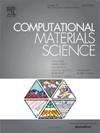A hybrid knowledge-guided and data-driven method for predicting low-alloy steels performance
IF 3.1
3区 材料科学
Q2 MATERIALS SCIENCE, MULTIDISCIPLINARY
引用次数: 0
Abstract
Low-alloy steels are essential engineering materials and precise prediction of their performance is crucial. Data acquisition in the steel industry is costly, and the available data volume is usually small. So far, with limited data, both traditional material modeling methods and data-driven machine learning cannot accurately build the relationship among material composition, process and performance. Although there is a wealth of experience and knowledge accumulated through extensive research in the steel field, combining the knowledge with data remains a significant challenge. To fully utilize domain knowledge, in this paper, a knowledge-driven graph convolutional network (KD-GCN) method is proposed for predicting the performance of low-alloy steels. Firstly, a knowledge graph is constructed by using steel knowledge from professional books. Then structured steel composition and processing data are transformed into a graph representation. Next, through a multi-layer graph convolutional network, the domain knowledge and structured data are fused to predict the strength and plasticity of steels. Furthermore, the proposed method is tested on a low-alloy steel dataset. Comparison results demonstrate that KD-GCN outperforms some other machine learning methods without using domain knowledge. Finally, feature importance analysis experiments show that the obtained influence of composition and process on steel performance is highly consistent with domain knowledge, which further validates the effectiveness of the proposed method.

求助全文
约1分钟内获得全文
求助全文
来源期刊

Computational Materials Science
工程技术-材料科学:综合
CiteScore
6.50
自引率
6.10%
发文量
665
审稿时长
26 days
期刊介绍:
The goal of Computational Materials Science is to report on results that provide new or unique insights into, or significantly expand our understanding of, the properties of materials or phenomena associated with their design, synthesis, processing, characterization, and utilization. To be relevant to the journal, the results should be applied or applicable to specific material systems that are discussed within the submission.
 求助内容:
求助内容: 应助结果提醒方式:
应助结果提醒方式:


